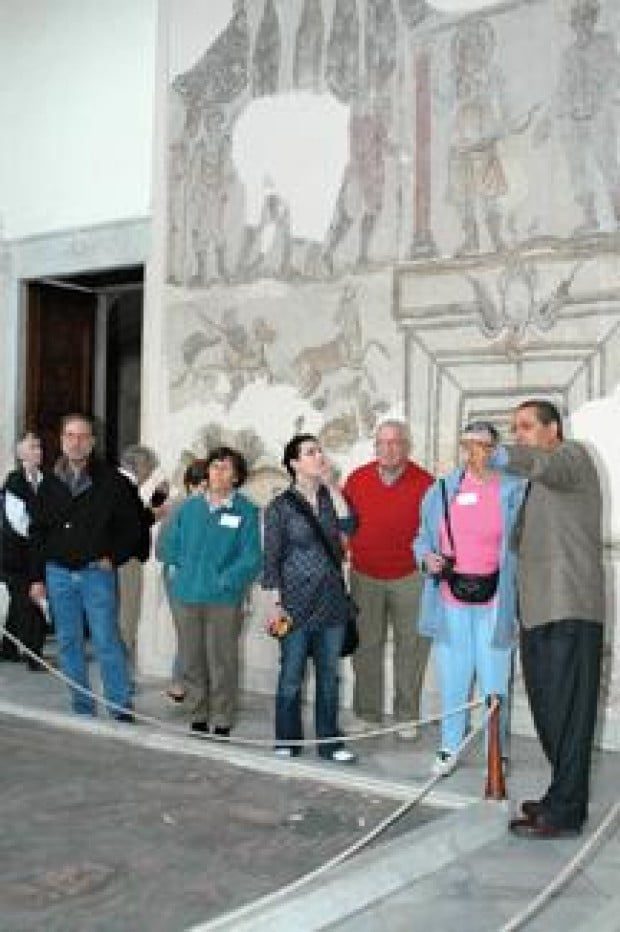After a 24-hour journey between Los Angeles International Airport and Tunis-Carthage International Airport, and enough in-flight exercises to challenge an ace astronaut, I landed in a country that seemed to be culturally confused. Or was it just me, with jet lag aching to be submerged in the nearest thalassotherapy spa?
Here I was in Tunisia, a petite country with Libya on the right and Algeria on the left, with more than enough shifting sand between to create a dozen artificial beaches in Las Vegas. Nearly everyone I encountered spoke French, buildings spread and soared with a futuristic flair, and yet, the call to prayer from scattered mosques remains a reliable way to tell time. It’s heard five times daily, rain or shine. And to confuse matters further, when it comes to defining what travel writers strive to define, that being “a sense of place,” Tunisia has more places to seduce than the senses can process. In the chic village of Sidi bu Said in Tunis, a splendid setting with buildings of white-edged, blue shutters, wooden doors shaped like oversized keys and sun-dappled narrow streets, I felt as if I could have been sipping the same peppermint tea somewhere in Greece. All of this prompted my companion to marvel at the cultural diversity one discovers in this stylish corner of Tunisia.
In the July issue of Vanity Fair, author Christopher Hitchens called Tunisia one of Africa’s “most successful countries.” A recent visit from Bill and Melinda Gates indicates something is happening here; maybe this is the next Silicon Valley? Could it be because Tunisia’s enlightened government earmarks a third of the annual budget for health and another third for education?
Tunisia fervently preserves and promotes its artistic heritage at the National Office of Handicraft. Workshops for designers and their apprentices provide a venue for purchasing original works of art, from delicate painted tea glasses to high fashion shoes and accessories hand carved from olive wood. And then we went on to visit the legendary Bardo Museum, where dazzling mosaics created by the Romans resemble lifelike portraits, composed from thousands of small colored stones strategically set in place.
We moved from Tunis to Hammamet, a popular resort, about a 50-minute ride on an excellent freeway that takes you through the wine country. Tunisian wine is exported to France, and their grappa made from figs is a popular digestive.
As we visited more than a dozen resorts and thalassotherapy spas, all on the edge of the shimmering Mediterranean, it became obvious that this part of Tunisia was reminiscent of Santa Monica or San Diego, with broad beaches and inspirational sunsets. No wonder the spas in this corner of paradise were justly proud of their lavish “couples” spa suites, in addition to excellent skincare services (most using French products).
With a commitment to cultivating tourism, four and five star hotels are creating throngs of European tourists and a growing number of visiting Americans. Thanks to quality tour operators such as TunisUSA (www.tunis.USA.com), there are several tours planned, such as “From Phoenicians to Berbers,” Oct.19-30 and, on March 4, “History, Culture and People.” New on the radar screen is the stunning Hasdrubal Thalassa & Spa opening later this year on the island of Djerba, a marvel of Mediterranean views, undulating pools, spa suites with the latest in thalassotherapy technology enhanced by ultra-luxurious accommodations. This hotel is part of the Hasdrubal group, operated by the Amouri family (with other resorts in Hammamet and Port El Kantaoui). The carefully curated family art collection, featuring Tunisian artists, is a story in itself. The Junior Suites are projected to start at $242, nightly double occupancy (www.hasdrubal-hotel.com).
The exchange rate here is in our favor: one American dollar buys $1.28 Tunisian dinars. That translates to about $100 night at Dar El Medina (www.darelmedina.com) in the Residence du Charme category, in the heart of the Medina in Tunis. This was once the residence of the family that now operates a successful inn. A few steps away are several restaurants in buildings so old (but meticulously restored) they could have inspired the Tales of the Arabian Nights. Dar El Jeld and La Falaise serve an assortment of delights such as cous cous, brik and fresh grilled tuna. Desserts, such as luscious fresh fruit arranged in oversized bowls (peaches, melons, plums and more) are irresistible. Tunisian’s healthy diet, with an accent on olive oil (some of the finest in the world is cultivated here) is alluring, too.
Pamela Price is the co author of “100 Best Spas of the World” (www.globepequot.com)
Travel Information:
www.tunisiaguide.com
Best Bet to reach Tunisia:
www.airfrance.com


